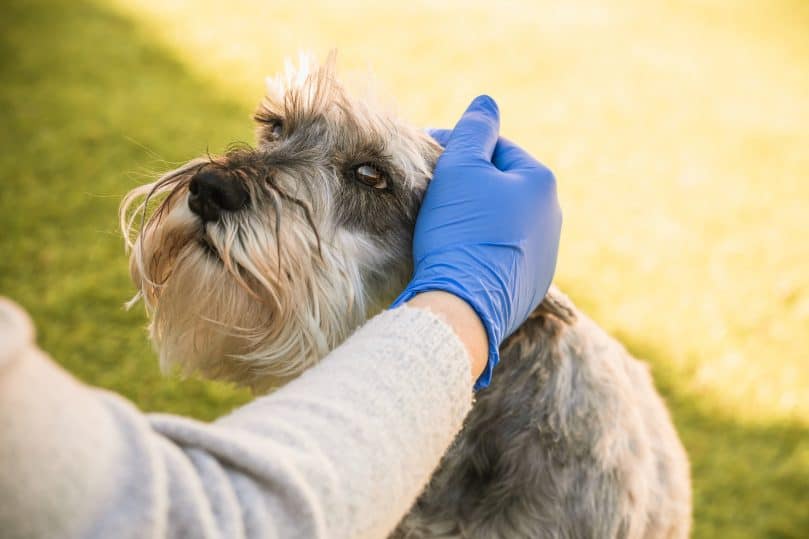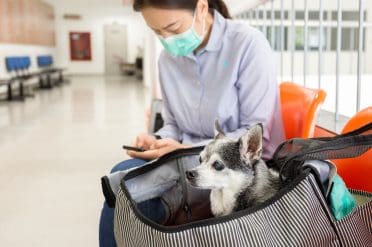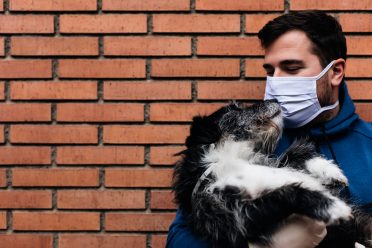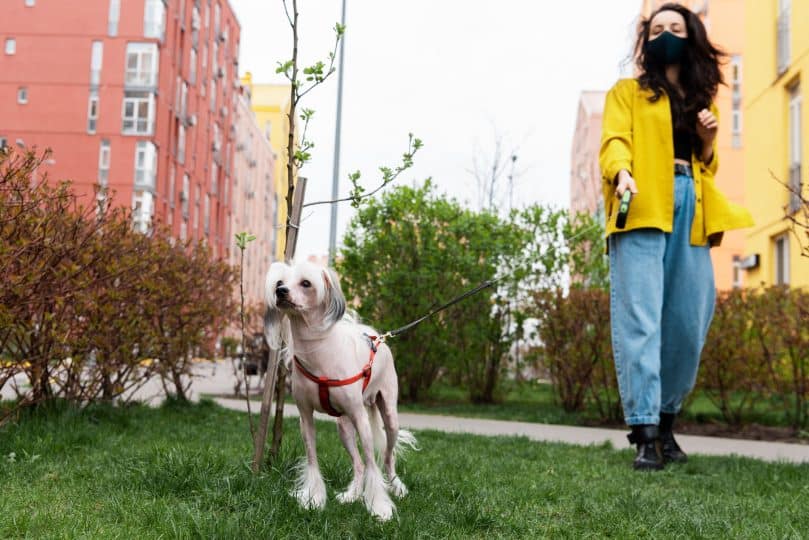This page contains affiliate links. We may earn money or products from the companies mentioned in this post through our independently chosen links, which earn us a commission. Learn More
The current coronavirus crisis has brought countries across the world to their knees. Amidst the many questions surrounding this new illness, dog owners everywhere are wondering, is my dog at risk?
While scientists are still learning about the new coronavirus, they’ve made steps in figuring out how pets are affected. Keep reading for the information you need to keep your pooch safe and healthy.
Contents & Quick Navigation
Interestingly, there are several different types of coronavirus. Many of them are species-specific, meaning they only cause illness in certain kinds of animals. One of these is Canine Enteric Coronavirus or CCoV.
This incredibly contagious disease only affects dogs. It spreads through contact with Fido’s favorite thing to sniff: poop. Your dog could also contract CCoV from an infected canine playmate.
Loose, orange, foul-smelling stool is a telltale sign of CCoV. Other symptoms include fever, fatigue, and loss of appetite.
While most dogs bounce back from CCoV, some contract or develop additional ailments while having this disease. Just like humans, dogs that have to fight off multiple infections have a harder time recovering.
Additionally, studies indicate that younger puppies may be less likely to overcome CCoV. To give your dog the best shot at a full recovery, call your vet right away if you suspect they’ve contracted CCoV, or if you notice your doggo showing even one sign of the symptoms mentioned.
Should your pet show signs of infection and you can’t reach your vet, you can still take steps to ease their stomach upset:
- Avoid feeding your dog for 24 hours after their diarrhea ends.
- Keep fresh water available at all times. (This is super important to combat dehydration!)
- When they’re ready, feed them small portions and slowly build-up to their regular amount of food.
Thankfully, there is a vaccine available for CCoV. If you haven’t already done so, reach out to your vet to discuss if this preventive measure is best for your pooch.

CCoV is one of many common coronaviruses, and it can be easy to confuse the different types. Here are some of the more prevalent:
Canine Respiratory Coronavirus (CRCoV) causes respiratory infection in dogs. CRCoV primarily spreads through the air, placing boarding facilities and kennels at risk for outbreaks. Currently, there is no vaccine available for CRCoV.
Feline Infectious Peritonitis (FIP) is a fatal coronavirus that affects cats. It can present with a variety of symptoms, including fever and difficulty breathing. Technically, there is a FIP vaccine, but it isn’t regularly recommended.
Severe Acute Respiratory Syndrome Coronavirus (SARS-CoV) may sound familiar. In 2003, a SARS epidemic erupted in over 8000 cases worldwide. SARS most likely originated in bats before spreading to civet cats and, ultimately, humans.
Middle East Respiratory Syndrome Coronavirus (MERS-CoV) is a coronavirus that can spread from camels to humans. MERS infections can be severe. Fortunately, no cases have been reported in the US since 2014.
Also called COVID-19 or SARS-CoV-2, the virus was first detected in Wuhan, China, in 2019.
You may be surprised to learn that the coronavirus behind the current pandemic has actually been around for some time. It wasn’t until the virus made the leap from its original animal host to humans that we took notice of it.
The first infected patients could all be linked to the same local seafood and animal market. Soon, however, COVID-19 spread through communities, countries, and entire continents. This ultimately led the World Health Organization (WHO) to declare the disease a global pandemic.
SARS-CoV-2 is highly contagious and can be deadly for some people. Because the virus was so recently discovered, scientists are still working on a vaccine.
After tigers and lions at a New York City zoo tested positive for COVID-19, pet parents began wondering if their fur babies could also become infected. It’s a valid concern as a total of three dogs and four cats (spread out between Hong Kong, Belgium, and the US) have since tested positive for the virus.
While almost all of these pets lived with people with COVID-19, the human-to-pup transmission isn’t a sure thing.
By March 31, only 3 dogs tested positive for COVID-19 in Hong Kong. Additionally, two veterinary diagnostic labs in the US tested thousands of samples from dogs and cats and didn’t have any positive results.
Also, in the US, a pup named Winston famously became the country’s first COVID-positive dog. If you haven’t seen the little guy on the news, take a second to get acquainted with his story:
What isn’t mentioned, however, is that the amount of virus in Winston’s initial tests was low enough that he didn’t technically meet the criteria for a positive test. And following tests actually came back negative.
Given these numbers, it seems possible that Fido could contract COVID-19 from an infected human, but not likely. Still, it’s important to note that there’s a great deal of mystery surrounding COVID-19 and that it’s better to be safe than sorry.
Coronavirus cases surged faster than researchers could study the new disease, resulting in many more questions than answers. What makes things more complicated is that scientists haven’t been able to conduct the autopsies critical to understanding COVID-19’s impact on the human body.
Between lockdowns and the high-risk nature of the disease, opportunities for research have thus far been limited. Be prepared for information to change as we learn more.
Can I contract SARS-CoV-2 from my pet?
The WHO and Centers for Disease Control and Prevention (CDC) both state that humans don’t need to worry about getting COVID-19 from their animals. There simply is no evidence that household pets can infect humans with the virus.
Still, you should wash your hands regularly, including after scratching your dog’s ears, getting your hand licked, or rubbing their belly. It may be wise to practice social distancing with other people’s pets, too.
Can I travel with my dog to or from regions with COVID-19?

Because the coronavirus situation looks different from place to place, there’s no uniform answer to this question. The general consensus, though, is that traveling during the coronavirus pandemic is not recommended.
If you can, reschedule your trip. If travel is unavoidable, try to find care for your pup while you’re away. This will keep both of you safer and make your trip much simpler.
If neither of these is possible, check with local travel authorities in the areas you want to visit. Contact travel agencies, embassies, and airlines to determine exactly what you need to do to import and export pets during the pandemic.
How can I keep my pets safe from SARS-CoV-2?
While the risk to pets seems minimal so far, it’s still wise to play it safe. One of the best ways to protect your dog (and yourself) during the pandemic is to keep them away from other people and animals.
Skip visits to the groomer and cancel upcoming doggy daycare appointments. Make this situation positive by grooming and playing your canine buddy by yourself – some sort of bonding moment.
You should also avoid crowded parks, and leave your pup at home if you go to the pet store.
For those who are near hiking areas, or have a spacious backyard, wipe down your pet’s paws and fur after going for walks or playing outside before they step back inside the house.

If you want to be extra careful, wash your hands before and after petting your dog. You may also choose to wear a face mask around your dog, but this isn’t necessary if you don’t have the virus.
Note that animals should never wear face masks. Even if there are masks explicitly created for pets with different muzzle sizes, it can lead to breathing difficulties and induce distress in some dogs. Besides, they aren’t guaranteed to prevent your dog from contracting SARS-CoV-2.
And even if your pet does contract the virus, they probably won’t experience severe symptoms. On the off chance that they do become symptomatic, separate them from other pets, and limit their exposure to uninfected humans.
This is particularly important for cats, as felines can spread COVID-19 to each other. Dogs should be kept away from feline companions and sick family members, but don’t need to be isolated themselves unless they show symptoms.
If you suspect your pet has COVID-19, contact your vet right away. Do not go to the veterinarian’s clinic in person. Your vet will likely direct you to track your dog’s symptoms and monitor their health. After all, a lot of medical health concerns are assisted online now.
COVID-19 tests are available for pets, but they aren’t always necessary. Your vet can help you determine if your dog needs to have his COVID status officially confirmed.
If I am diagnosed with COVID-19, how do I protect my pet?
Finding out you have the Novel Coronavirus can be terrifying. Figuring out how to care for your pet while you’re sick can feel even scarier.
If you’re diagnosed with SARS-CoV-2, you’ll want to limit contact, not only with people but with your pet as much as possible. Depending on your symptoms, it may be challenging to walk your dog or take him out to go potty.
The best course of action? Draw up an emergency care plan now, even if you aren’t sick.
Start by identifying 1 to 3 people who can take care of your pup if you can. They will serve as your care team.
Ideally, you won’t have physical contact with these people regularly, but they’ll still be familiar faces to your pooch. If your dog doesn’t know them well, consider using socially-distant introductions to ensure your pet is comfortable with their new sitters.
Next, determine what “care” looks like for your pet. Will Fido need to be exercised? Fed? Taken to appointments? Swept away on a doggy vacation while you recover? Iron out those details as early as you can.
You can also divide these duties between your team to lighten the load. Perhaps Person A takes care of feeding and brushing Fido, while Person B takes Fido for a daily jog.
You should also move pet supplies like leashes or treats near your main door. Making these easily accessible keeps your care team from interacting with you or touching surfaces in your home to find what they need.
Lastly, share the care plan with your team, your family, and your vet. Make sure everyone is on the same page. Don’t forget to provide information on how much food, exercise, or medication your dog needs and how often.
You can also inform them of the details about your pet’s personality and behaviors, which is particularly crucial for less-than-social pups!
Then, provide a list of contact information for everyone involved in your pet’s care.
If you can’t find alternative care for your pup while you recover, adopt the same behaviors around them as you do in public. Avoid contact as much as possible, wear a mask, and wash your hands before touching or petting your dog.

Technically, dogs can carry the coronavirus, but it’s rare. Additionally, there’s no evidence that dogs can transmit the virus to people.
As we mentioned earlier, the key here: it’s always better safe than sorry. Social distancing applies to your pup, too, so keep them out of range of other people and pets as much as you can.
What other questions do you have about the coronavirus and dogs? Tell us in the comments and let’s discuss with fellow pet parents!

Leave a Reply